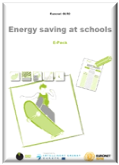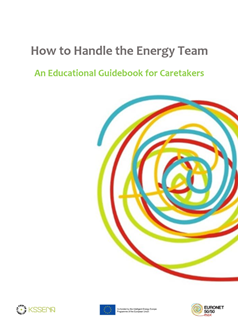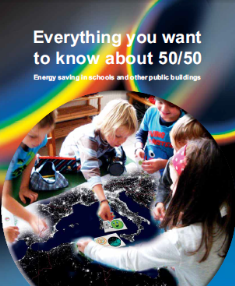 Broschüre “Energiesparen an Schulen”
Broschüre “Energiesparen an Schulen”
Diese Broschüre zeigt Schritt für Schritt, wie die 50/50-Methode in einer Schule umgesetzt werden kann. Es enthält wichtige Informationen und Hinweise für Lehrkräfte, die sie bei ihrer Arbeit mit dem Energieteam der Schule unterstützen. Zusätzlich enthält es Arbeitsblätter und Experimente, die zur Vermittlung des erforderlichen Wissens im Bereich Energie und Klima genutzt werden können. Für den Download klicken Sie hier.
 Broschüre “50/50 Schritt für Schritt. Energieeffizienz und Energiesparen an Schulen“
Broschüre “50/50 Schritt für Schritt. Energieeffizienz und Energiesparen an Schulen“
Diese Broschüre informiert auf prägnante Art über die Ergebnisse des ersten EURONET 50/50-Projektes. Sie enthält viele nützliche Tipps für die Durchführung eines 50/50-Projektes in Schulen. Hier erfahren Sie, wie Sie das Projekt am besten beginnen und betreuen, wie die Energieeinsparungen berechnet werden, und viele gute Beispiele einer erfolgreichen Umsetzung von Schulen des 50/50-Netzwerkes. Zum Downloaden klicken Sie hier.
 Guidebook “How to handle the energy team”
Guidebook “How to handle the energy team”
Guidebook is addressed to school caretakers (although also the teachers involved in the 50/50 project will find here many useful tips!) and will help them to prepare for the work with the energy team, including co-organisation of the energy review of the school building. Caretakers play very important role in the 50/50 project as they know best the school building and its energy system. Therefore, they can help the pupils analyse energy situation of their school and implement energy-saving measures. The publication contains many useful guidelines how to organise the work with the children, what information to transfer to them, as well as will help to prepare for the possible questions raised by the pupils. To download the guidebook, click here.
 Guidebook “Energy saving in public buildings”
Guidebook “Energy saving in public buildings”
This publications complements the guidebook „Energy saving at school” which was issued in the previous edition of the project. It focuses on implementation of the 50/50 methodology in non-educational public buildings. It informs what criteria must be met by these type of buildings, if they wish to engage in the 50/50 project, what is the role of local/regional self-government and the energy team, as well as explains step by step how to implement the 50/50 methodology in order to achieve energy and financial savings. To download the guidebook, click here.
 Guidebook "Everything you want to know about 50/50"
Guidebook "Everything you want to know about 50/50"
The guidebook summarises all our experience gained within the 3 years of EURONET 50/50 MAX implementation that may be useful for other schools, buildings and municipalities wishing to launch the 50/50 project. It includes overall description of the 50/50 concept and following steps of the 50/50 methodology with some useful, practical tips and guidelines. It also presents many fascinating best practice examples from the 13 partner’s countries, actions developed by the 50/50 schools and public buildings, summary of the project results and much more. To download the guidebook, click here.
 Guidebook "Benefits of applying 50/50 in public buildings"
Guidebook "Benefits of applying 50/50 in public buildings"
The guidebook summarises main aspects of implementation of the 50/50 concept in different types of public buildings. It highlights benefits of such approach, including contribution to the achievement of local climate & energy targets and demonstrating local authorities' commitment towards sustainable energy development. It also gives some useful tips about engaging building managers and building users in energy-saving actions. And by doing that significant energy savings can be achieved without large investments. To download the guidebook, click here.
















 Die alleinige Verantwortung für den Inhalt dieser Webseite liegt bei den AutorInnen. Er muss nicht unbedingt die Meinung der Europäischen Union wiederspiegeln. Weder die EACI noch die Europäische Kommission sind für jegliche Verwendung der darin enthaltenen Informationen verantwortlich.
Die alleinige Verantwortung für den Inhalt dieser Webseite liegt bei den AutorInnen. Er muss nicht unbedingt die Meinung der Europäischen Union wiederspiegeln. Weder die EACI noch die Europäische Kommission sind für jegliche Verwendung der darin enthaltenen Informationen verantwortlich.